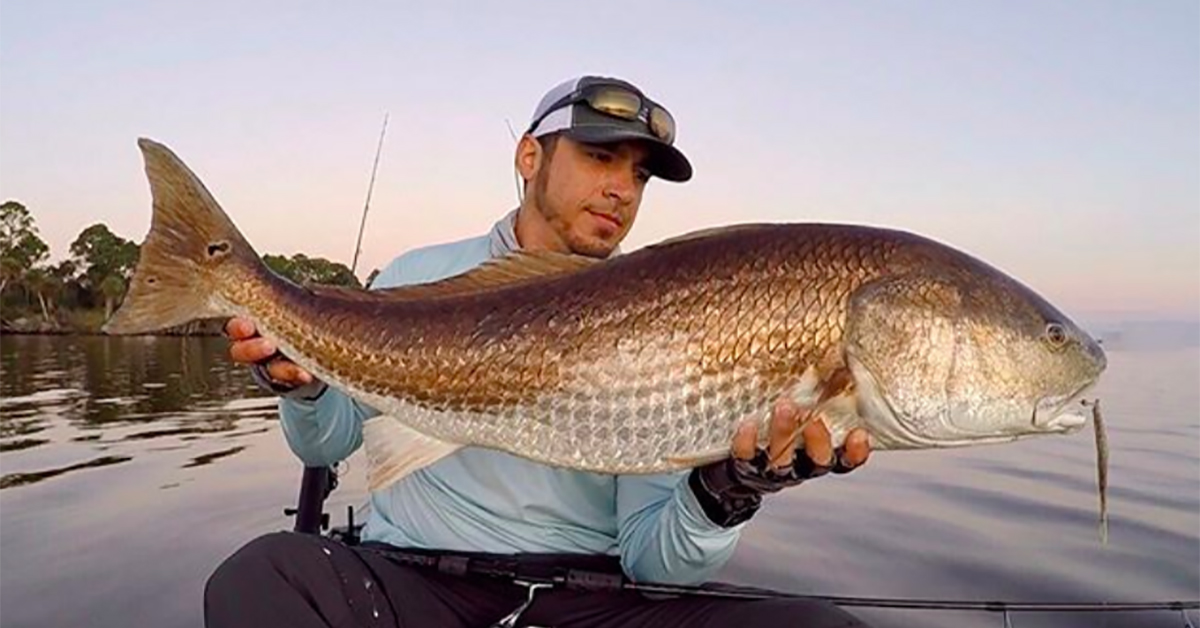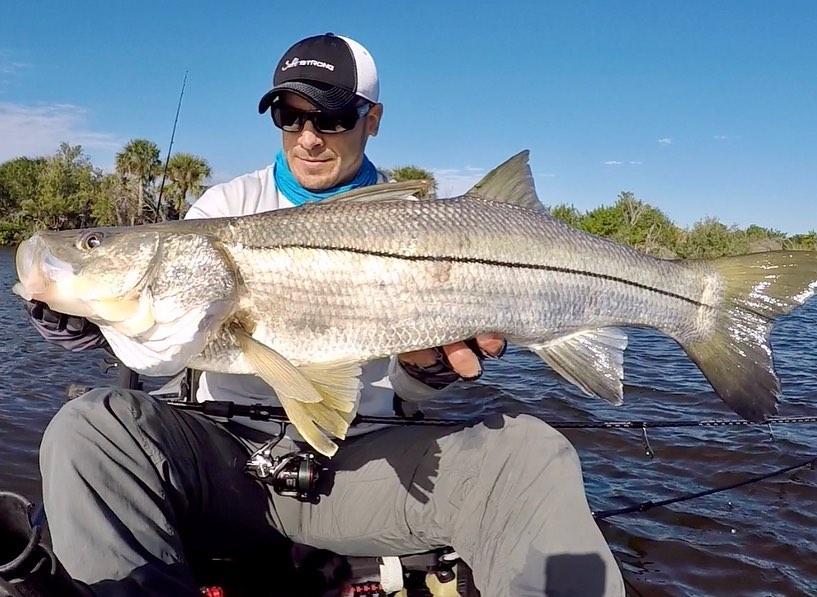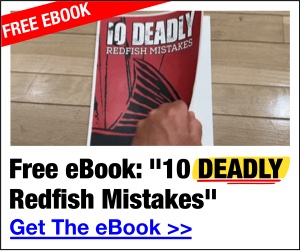This Is Why You Should Use Light Line When Inshore Fishing
- By: Tony Acevedo
- on

This might be the most underrated aspect of inshore fishing:
Your line diameter.
Most people are using line that’s way too thick for the situation they’re fishing in, and it’s costing them lots of fish.
It’s harder to cast, makes more commotion in the water, and causes more wind knots than light line.
If you’re fishing around areas with heavy structure, like jetties, bridges, and piers, then yes, you’ll want stronger line, but if you’re fishing areas like inshore flats, creeks, coastal marshes, or mangrove islands, then you should be using line that’s as light as possible.
Watch the video below to learn:
- the 4 reasons why you should be using light line
- the best type of braided line
- why lighter line can help you catch more fish
- and much more
Enjoy!
4 Reasons To Use Light Line [VIDEO]


You might be thinking, “Tony, I fish for big redfish and snook, there’s no way I can use light line!”
Well, I’ve been using 10 lb PowerPro the past few years and I’ve had no problems landing 50-inch redfish with it.
Braided line is incredibly strong and a lack of line strength is usually not why you’ll lose a fish.
Plus, using heavy line can decrease your chances of getting big fish to bite, and if they don’t bite in the first place, you certainly won’t catch them.
Here are four reasons why you should use light line:
1. You can cast farther
If you can cast just 10 feet farther per cast, and you make 100 casts over the course of a day, that’s an extra 1,000 feet of water covered in one day.
That’s more than three football fields!
2. You can cast more accurately
Fish are often holding tight to structure, near a point, or in a pothole, so if you can accurately place your lure where you want it to go, you’ll increase your shot at catching fish.
3. Thinner line is more stealthy in the water
When you’re retrieving your lure, or you have a baitfish swimming on the end of your line, your line is moving in the water and giving off vibrations.
If the line is thicker, it will give off more vibrations, which the fish can feel in their lateral lines, but if it’s thinner, it will give off fewer, smaller vibrations.
4. Thinner line results in fewer wind knots
If you’re using light lures and heavy line, the line may double over itself as you’re casting, causing wind knots.
Check out this article to learn more about why wind knots happen and how to prevent them.
Conclusion

If you’re fishing relatively open inshore waters such as flats, coastal marshes, and creeks, you should be using line that’s as light as possible.
It’ll help you catch more fish because it’s stealthier than thicker line and you can cast farther and more accurately.
Plus, you’ll get fewer wind knots.
I use 10 lb PowerPro and have caught 50-inch redfish without a problem.
Have any questions about using light line?
Let me know in the comments below.
And if you know someone who needs to scale back their line, please TAG or SHARE this with them!
P.S. Want access to our best fishing spots and tips, and discounts to our online tackle store? Click here to join us in the Insider Club!
Stop Wasting Time On The Water!
Do what the “SMART ANGLERS” are doing and join the Insider Club.
Here’s what you’ll receive today when you join:
- Weekly fishing reports and TRENDS revealing exactly where you should fish ever trip
- Weekly “spot dissection” videos that walk you through all the best spots in your area
- Exclusive fishing tips from the PROS you can’t find anywhere else
- Everything you need to start catching fish more consistently (regardless if you fish out of a boat, kayak, or land).
Click here to join today.
Related articles:
Related categories:
STOP WASTING TIME ON THE WATER!
Do what the “SMART ANGLERS” are doing and join the Insider Club.
Here’s what you’ll receive today when you join:
- Weekly fishing reports and TRENDS revealing exactly where you should fish every trip
- Weekly “spot dissection” videos that walk you through all the best spots in your area
- Exclusive fishing tips from the PROS you can’t find anywhere else
- Everything you need to start catching fish more consistently (regardless if you fish out of a boat, kayak, or land).










Heavier line is easier to cast and gets less wind knots than thinner braid. Thin diameter line also tends to dig into the spool more easily than heavier line. I won’t fish anything lighter than 30lb braid, not that much of a difference in diameter than 10lb but much stronger
Hey Tony, I’m going to FL for my first time ever in April. Super stoked to try out some shore fishing, maybe to a charter. What’s the length of your leader you have tied onto the braid, also what knot? I’ve always gone with the double-uni. And do you have any tips for what baits to throw that time of year? I’ll be fishing the west side near Tampa, likely gonna bring some bucktails jigs, topwater spook / poppers, spoons, and definitely live shrimp if I can find it. Cheers bro
Hey Ian!
I attach about 2ft of leader using an FG knot, but a double uni works just fine. If you’re going to be fishing here in April, All I would really throw is a topwater early in the morning and a 3 to 4 inch slam shady paddle tail the rest of the day. Keep it simple and focus more on finding good spots rather than having a large lure selection.
What if my reel has 22lb of drag. Idk what to put on it for big inshore fish like tarpon, jacks, and bull reds/blacks. I use a bg4500 with a medium heavy rod.
The drag tension should be based on the strength of the line use. Here’s an article that discusses the details: https://saltstrongdev.wpengine.com/articles/proper-drag-tension-for-a-fishing-reel/
EXACTLY!!!
Yeah buddy!
Hi Tony. I recently purchased a Kyak for fishing inshore water and since you are the person that I see in the Salt Strong videos fishing in the Yak I wounder if you could recommend a make and model rod that you are using. I will target redfish, black drum, speckled trout, and flounder.
Thanks as always, keep up the very informative videos
DW
Hey David!
I have been using a custom Century Weapon Jr made by Black Pelican Custom Rods. It’s a 7’6 fast action rod.
Now I do most of my fishing while standing in the kayak so I am used to using standard spinning rods in that 7’6 length which helps with casting distance, leverage on the fish, and casting accuracy. If you are mainly sitting down while fishing you may want to go with a rod that is made specifically for kayak fishing. These rods have a shorter butt section so it doesn’t get in the way while seated.
St Croix sells a kayak specific rod called the Mojo Yak Spinning rod. I would recommend this in the 7’0 MF action (model MY70MF).
The good news is we sell these on our shop page, and the even better news is that if you are an Insider member you get an extra 20% off:
https://shop.saltstrong.com/products/st-croix-mojo-yak-spinning-rods?_pos=2&_sid=f27b51b58&_ss=r
Hey Tony
I took your advice and went to the saltstrong products and I really like the St. Croix mojo yak spinning rod but nobody seems to know the availability of this rod. Any suggestions as to who I could talk to in your organization to find this out?
Thanks
David W
Hey David. I didn’t know about the Mojo Yak and purchased a standard Mojo 7 1/2′ MF for inshore in my kayak (I’m also new to it). Briefly…I love it. Great inshore rod and the length of the butt has not bothered me much.
Hey David! Send an e-mail over to mark@saltstrong.com
Mark takes care of all of the products for the site.
Thanks Tony, just wanted you to know that the ST. Croix rods are no longer available
No problem David! Yes unfortunately with whats been going on a lot of companies have been shut down and production has slowed down on a lot of products. Many shops are out of stock until the companies start production again.
We do have the St. Croix Triumph rods in stock. It says “freshwater” on the image but they are built for inshore or freshwater. Great rod for the price! I have 2 of the TRS76MHF models.
https://shop.saltstrong.com/collections/saltwater-spinning-rods/products/st-croix-triumph-spinning-rods
Great video Tony,
Two quick questions for you.
1. I’m in Texas and fish a lot of areas with oyster reefs. Do you still recommend the 10lb? I’ve been using 20 for the past few years and have thought that I could even go lighter but never want to risk breaking one off on the reef.
2. Do you still use 10lb with popping corks or do you bump up reel and line size?
Thanks for everything that you and the rest of the Salt Strong crew put out!
Thanks Gage!
Oysters can easily break 10lb and even 20 or 30 due to how sharp they are. In that case I would increase the size of my leader for more abrasion resistance. However, a stronger line will allow you to pull those fish away from the structure more efficiently. If the majority of your fishing is near heavy structure I wouldn’t recommend 10lb because you want enough strength to pull those fish away from it.
I still use 10lb and my 3000 size reels with popping corks. It helps to tie a short section of mono between your mainline and the cork (a short leader) to help keep the bradi from tangling around the cork.
Are you using 10 lb main and leader in braid? Is this for any specific setup (other than what you mentioned about structure)? Thinking along the lines if you vary your setup for corks vs top water baits vs jigs.
Newer to saltwater fishing so trying to get a feel for how I should setup a couple first rigs and any recommendations you have for inshore fishing (surf and jetty). Thanks in advance and loving the site! .
Hey Nick,
I use 10lb braid as my main line, and then 20 or 30lb fluorocarbon leader or mono leader (20lb for reds and trout, 30 for snook).
This is pretty standrad for all types of setups for inshore – live bait, artificials, corks, no corks, etc.
You’re using too heavy a line, Tony. You need to try 8lb Suffix 832.
Naaah. I’ve used 8lb and have had the line pop just by tightening knots. When that happens it’s a bit too light for my liking.
I/m really surprised. I’ve had no problem with it.
I usually carry a couple of rods with Power Pro 5lb braid, superb for casting small baits like a Slam Shady 2 or Ned rig. PP 10lb on the other 2-3 rods I take along.